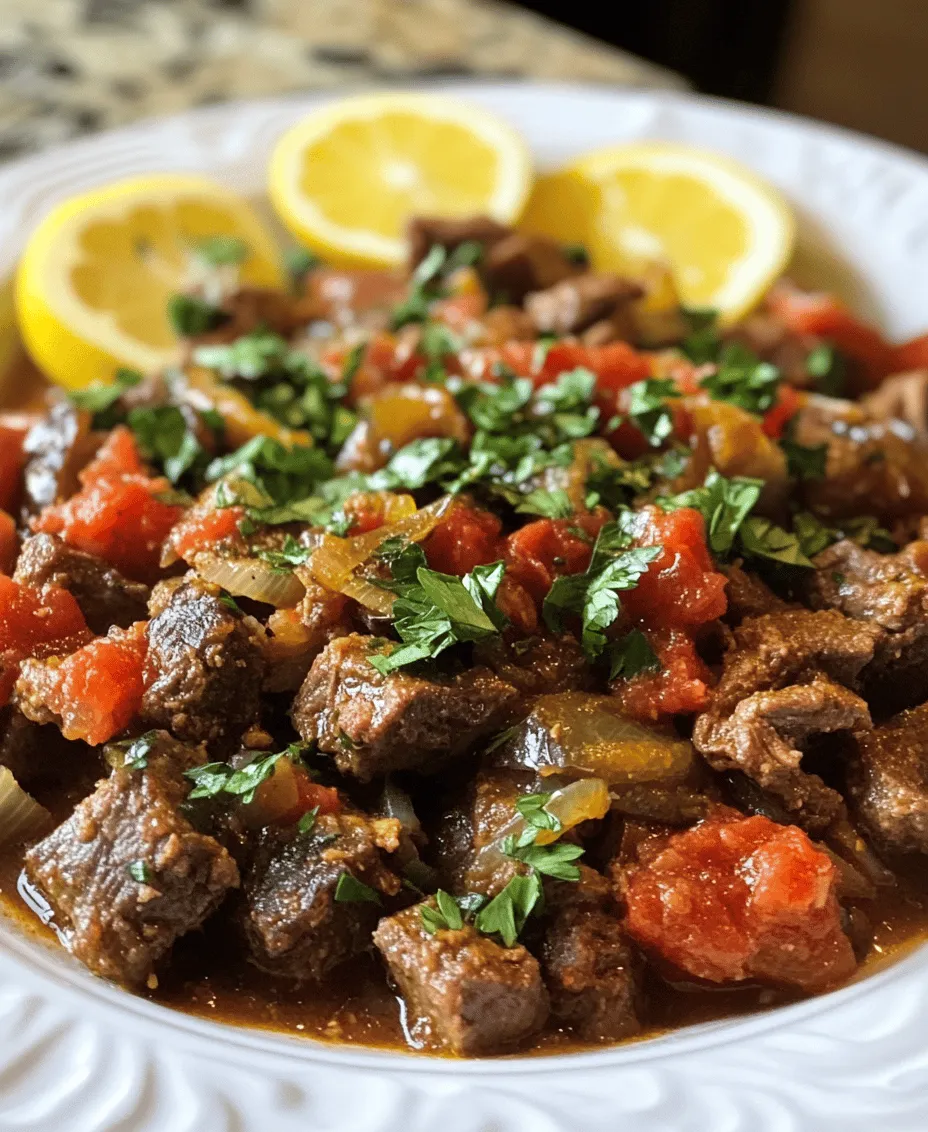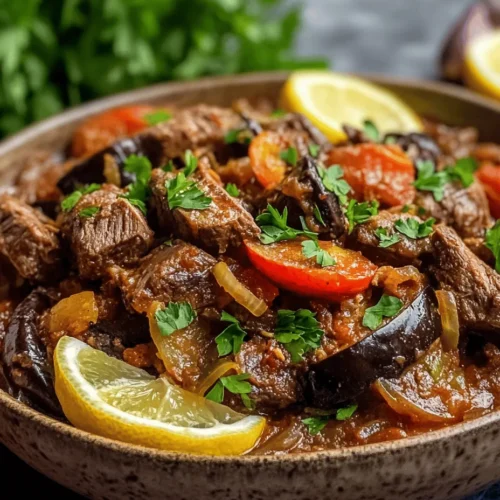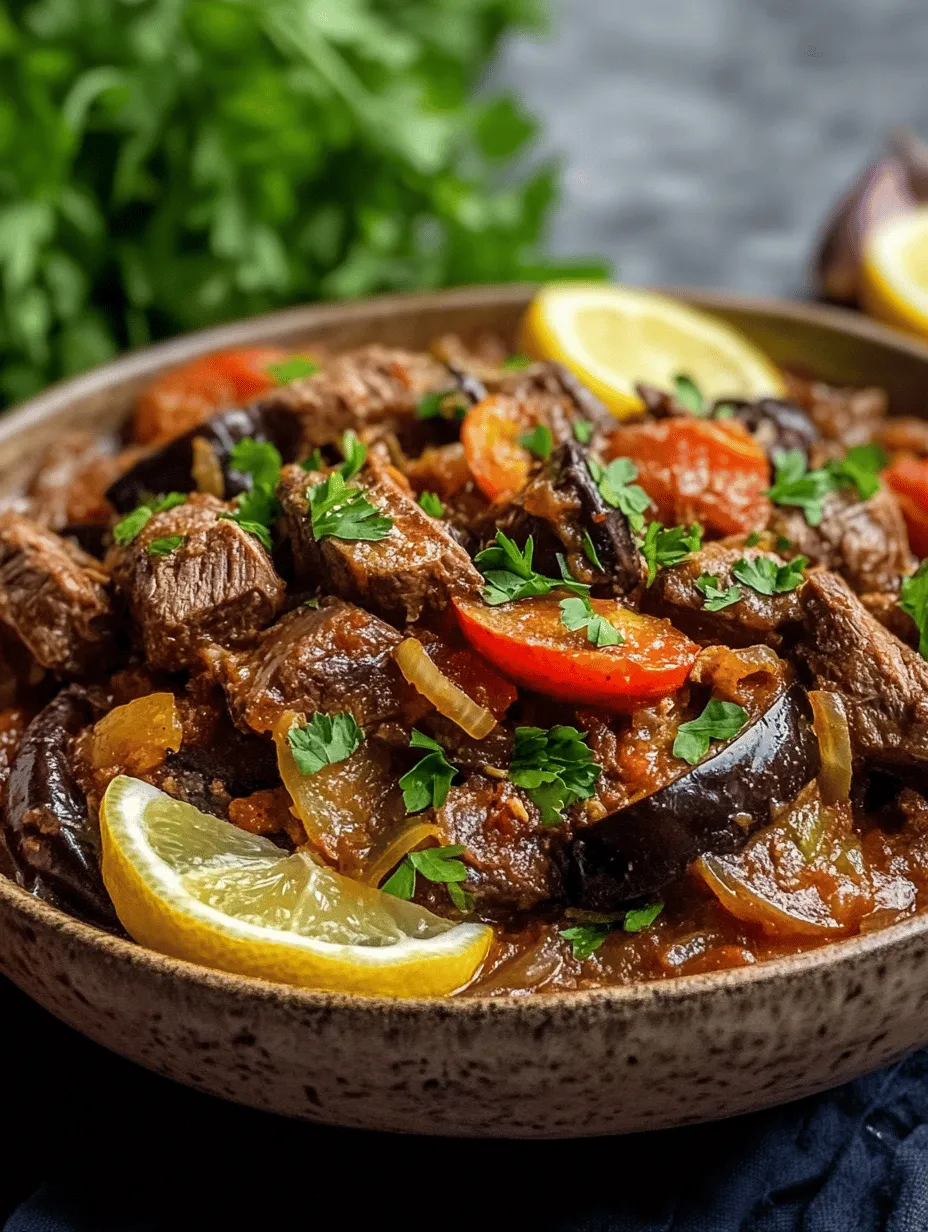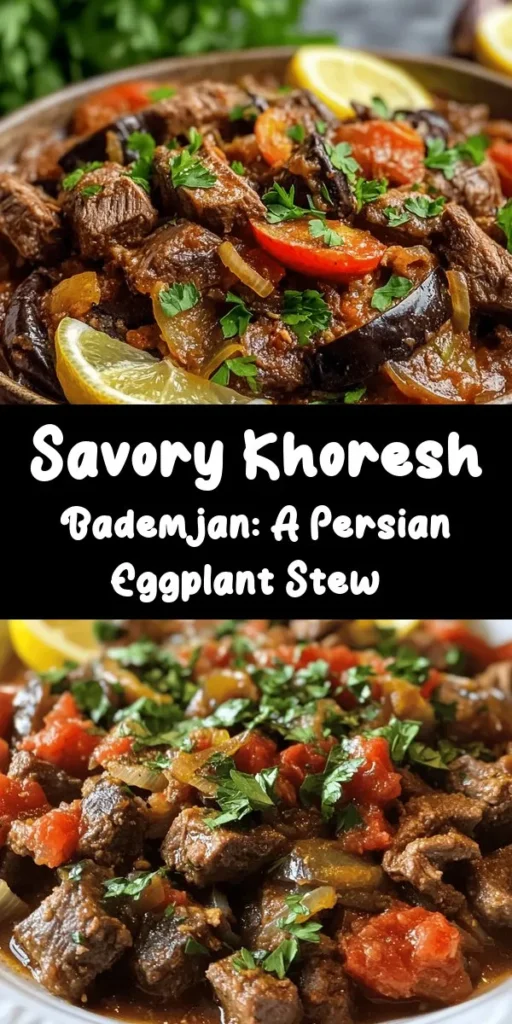Khoresh Bademjan, a traditional Persian stew, is a culinary masterpiece that embodies the rich tapestry of flavors characteristic of Iranian cuisine. When you think of Persian dishes, you might envision the fragrant aroma of spices wafting through the air, the vibrant colors of fresh ingredients, and the comforting warmth of a well-cooked meal. Khoresh Bademjan is no exception; it masterfully combines tender chunks of lamb or beef with the unique texture of eggplants, creating a dish that is both hearty and satisfying.
This delightful stew not only serves as a staple in Persian households but also showcases the cultural significance of communal dining in Iran. Families gather around a table, sharing stories and laughter over a steaming pot of Khoresh Bademjan, cultivating a sense of togetherness and warmth. As we embark on the journey of preparing this beloved dish, we will explore its key ingredients, the techniques that elevate its flavors, and the cultural heritage that makes Khoresh Bademjan a true culinary delight.
Understanding the Ingredients: Key Components of Khoresh Bademjan
The Essence of Eggplants in Persian Cuisine
At the heart of Khoresh Bademjan lies the humble eggplant, a vegetable that holds a special place in Persian cooking. Eggplants are not only prized for their unique texture but also for their ability to absorb flavors beautifully. In Khoresh Bademjan, they take on the essence of the aromatic spices and the rich sauce, providing a luscious mouthfeel that is hard to resist.
From a nutritional standpoint, eggplants are a powerhouse of benefits. They are low in calories yet rich in dietary fiber, making them an excellent choice for those looking to maintain a healthy diet. Additionally, they contain antioxidants, vitamins, and minerals that contribute positively to overall health. The subtle, slightly bitter flavor of eggplants adds depth to the stew, balancing the richness of the meat and the spices.
Choosing the Right Meat: Lamb vs. Beef
When it comes to selecting the meat for Khoresh Bademjan, both lamb and beef have their merits. Lamb, often regarded as the traditional choice, brings a unique flavor that pairs beautifully with the spices and eggplants. It tends to be more tender and can impart a rich, gamey taste to the stew, enhancing the overall experience.
On the other hand, beef also makes for a delicious Khoresh Bademjan. When cooked properly, it can be just as tender and flavorful as lamb. The choice between the two often comes down to personal preference or availability. Whichever meat you choose, it’s essential to select quality cuts that are well-suited for slow cooking. Look for cuts like lamb shoulder or beef chuck, which are known for their marbling and ability to become tender during the cooking process.
A Symphony of Aromatic Spices
The magic of Khoresh Bademjan lies not only in its ingredients but also in the harmonious blend of spices that elevate the dish to new heights. Turmeric, cinnamon, and saffron are the standout spices in this recipe.
Turmeric brings warmth and a vibrant golden hue to the stew, while also offering numerous health benefits, including anti-inflammatory properties. Cinnamon adds a subtle sweetness and complexity, enhancing the overall flavor profile. Saffron, often referred to as “red gold,” is a luxury spice that imparts a unique aroma and a touch of elegance to the dish. The combination of these spices creates a symphony of flavors that is quintessentially Persian, making Khoresh Bademjan a true delight for the senses.
The Role of Broth and Tomatoes
To create a rich and flavorful stew, the choice of broth is crucial. While vegetable or chicken broth can be used, a well-made beef broth enhances the umami profile of the dish, making it even more satisfying. The broth provides the necessary moisture for simmering the meat and vegetables, allowing their flavors to meld beautifully.
Tomatoes play an equally important role in Khoresh Bademjan. They add acidity and sweetness, balancing the richness of the meat and the earthiness of the eggplants. You can use fresh tomatoes or canned tomatoes, depending on what is available and in season. Fresh tomatoes will provide a vibrant flavor, while canned tomatoes can offer convenience without sacrificing taste.
Preparation Steps: Crafting Your Khoresh Bademjan
Now that we have explored the key ingredients that make Khoresh Bademjan a standout dish, it’s time to dive into the preparation process. The following steps will guide you through crafting this delicious stew, ensuring that each component is cooked to perfection.
Preparing the Eggplants
The journey to a perfect Khoresh Bademjan begins with the preparation of the eggplants. One of the critical steps in this process is salting the eggplants, which helps to reduce their inherent bitterness and improve their texture. To do this, slice the eggplants into rounds or cubes, depending on your preference. Sprinkle generous amounts of salt over the cut surfaces and let them sit for about 30 minutes. This process draws out excess moisture and bitterness from the eggplants.
After 30 minutes, rinse the eggplants under cold water to remove the salt and any bitterness. Pat them dry with a paper towel to ensure they are ready for frying. Properly preparing the eggplants is essential for achieving the right texture and flavor in the final dish.
Frying the Eggplants: Techniques and Tips
Frying the eggplants is a crucial step that enhances their flavor and helps to achieve a desirable texture. In a large skillet or frying pan, heat a generous amount of oil over medium heat. Once the oil is hot, add the eggplants in batches to avoid overcrowding the pan. Fry them until they are golden brown and tender, which should take about 4-5 minutes per side.
Achieving the perfect golden brown color is vital, as it adds depth and richness to the stew. If you prefer a lighter version of Khoresh Bademjan, you can opt for baking or grilling the eggplants instead of frying, though this may alter the final flavor slightly.
Sautéing the Aromatics: Onions and Garlic
Once the eggplants are fried and set aside, it’s time to focus on the aromatics that will form the base of your stew. In the same skillet, add a bit more oil if necessary and sauté finely chopped onions over medium heat. Sautéing the onions until they are translucent and lightly golden is crucial for developing the flavor of the dish.
Add minced garlic to the pan and continue to sauté for an additional minute, allowing the garlic to infuse its flavor into the oil. The combination of sautéed onions and garlic creates a fragrant foundation that will elevate your Khoresh Bademjan to new heights.
Cooking the Meat: Building the Stew
Now that the aromatics are ready, it’s time to introduce the meat into the mix. Add the chunks of lamb or beef to the pan and increase the heat to medium-high. Browning the meat is an essential step, as it enhances the flavor through the Maillard reaction, creating a rich and savory base for your stew.
Allow the meat to brown on all sides, which should take about 5-7 minutes. Once browned, add in the previously prepared eggplants, the chosen broth, and your aromatic spices, including turmeric, cinnamon, and saffron. Stir to combine, ensuring that the spices coat the meat and vegetables evenly.
As you continue to prepare Khoresh Bademjan, you’ll notice the delightful aroma of the spices melding with the meat and eggplants, creating anticipation for the comforting meal to come.
In the next section, we will cover the remaining steps to complete this exquisite Persian stew, including simmering the ingredients to perfection and serving suggestions that make Khoresh Bademjan a memorable dish for any occasion.

Step-by-Step Process of Adding Spices and Tomatoes
Once the meat has been browned and the onions are translucent, it’s time to infuse your Khoresh Bademjan with rich flavors. Begin by adding spices that are essential to Persian cooking, creating a fragrant base for your stew.
1. Adding Spices: Introduce turmeric and saffron to the pan. Turmeric provides a warm, earthy flavor and a vibrant color, while saffron adds a touch of luxury and a subtle aroma. Stir these in and allow them to toast for about a minute, which will help release their essential oils and deepen their flavors.
2. Incorporating Tomatoes: Next, add your diced tomatoes or tomato paste. Fresh tomatoes will provide a bright acidity that balances the richness of the meat and eggplant. If you’re using tomato paste, consider adding a splash of water to help it integrate smoothly. Stir everything together, ensuring the meat is well-coated with the tomato and spices.
3. Simmering the Stew: Patience Pays Off
With your spices and tomatoes mixed in, it’s time to let the stew simmer. This step is crucial as it allows the flavors to meld beautifully, resulting in a tender and aromatic dish.
– Understanding the Simmering Process for Tender Meat: Lower the heat to a gentle simmer. A simmer is characterized by small bubbles gently breaking the surface of the liquid. This slow cooking process is ideal for tenderizing tougher cuts of meat, allowing them to absorb the flavors of the spices and tomatoes fully.
– Ideal Time and Temperature for the Perfect Stew: Aim to simmer Khoresh Bademjan for at least 1.5 to 2 hours. The ideal temperature should be around 180°F to 200°F (82°C to 93°C). A longer simmering time will result in fork-tender meat and a rich, flavorful broth. Stir occasionally to prevent sticking and to ensure even cooking.
Incorporating Eggplants: Final Touches
While your stew is simmering, it’s the perfect time to prepare the eggplants, which are the star of Khoresh Bademjan.
1. Frying the Eggplants: Slice the eggplants into thick pieces, about 1-inch thick. Lightly salt them and let them sit for about 30 minutes to draw out excess moisture and bitterness. Afterward, rinse and pat them dry. Heat oil in a separate skillet and fry the eggplant slices until they are golden brown on both sides. This step not only enhances their flavor but also helps them maintain their shape in the stew.
2. Adding Fried Eggplants at the End: Once your stew has reached that perfect simmer and the meat is tender, gently fold the fried eggplants into the pot. Let them cook with the stew for an additional 15-20 minutes. This allows the eggplants to absorb the savory broth while still retaining their texture.
3. Importance of Melding Flavors for a Cohesive Dish: Allowing the eggplants to simmer with the stew for a short time is essential for melding the flavors. This final touch ensures that each bite of Khoresh Bademjan is a harmonious blend of tender meat, rich sauce, and perfectly cooked eggplant.
Serving Suggestions: Presenting Khoresh Bademjan
When it comes to serving Khoresh Bademjan, presentation can elevate the dining experience.
Garnishing for Visual Appeal
– How Fresh Parsley Enhances Presentation: Just before serving, chop some fresh parsley and sprinkle it over the stew. This not only adds a pop of color but also a fresh, herbal note that brightens the overall flavor profile.
– The Role of Lemon Slices in Balancing Flavors: Serve alongside lemon slices, which diners can squeeze over their portions. The acidity from the lemons balances the rich flavors of the stew and brightens the dish, making each bite a delightful experience.
Ideal Accompaniments: What to Serve With Khoresh Bademjan
Khoresh Bademjan is traditionally served with basmati rice, which is a staple in Persian cuisine.
– Traditional Basmati Rice: Why It Matters: The fluffy texture and nutty flavor of basmati rice complement the richness of the Khoresh beautifully. To prepare, rinse the rice until the water runs clear to remove extra starch. Soak it for at least 30 minutes, then cook it with a pinch of salt until fluffy. The rice will soak up the stew’s sauce, creating a perfect balance of flavors.
– Exploring Other Side Dishes That Complement the Stew: You may also consider serving Khoresh Bademjan with a fresh salad, such as Shirazi salad, made with diced cucumbers, tomatoes, onions, and a simple lemon-olive oil dressing. This light, refreshing salad provides a crisp contrast to the richness of the stew.
Cultural Significance: Khoresh Bademjan in Persian Heritage
Khoresh Bademjan is more than just a delicious meal; it is steeped in Persian history and culture.
The History of Khoresh Bademjan
– Origins and Evolution of the Dish Through the Ages: Khoresh Bademjan dates back centuries, evolving from traditional Persian stews. The use of eggplants can be traced to the early interactions between Persian and Mediterranean cuisines, particularly during the time of the Silk Road.
– Regional Variations and Personal Adaptations: As with many traditional dishes, variations exist based on regional ingredients and personal preferences. Some may add different vegetables, such as potatoes or bell peppers, while others might adjust the spice levels to suit their palate. Each adaptation tells a story of the cook’s heritage and creativity.
Celebrating with Khoresh Bademjan: Occasions and Traditions
– When and How This Dish Is Typically Served: Khoresh Bademjan is often served during family gatherings, special occasions, and festive celebrations. It is a dish that brings people together, symbolizing hospitality and warmth.
– Family Gatherings and Its Place in Persian Hospitality: In Persian culture, sharing a meal is a cherished tradition. Khoresh Bademjan, with its rich flavors and comforting nature, is an ideal centerpiece for family gatherings, allowing everyone to partake in a communal dining experience.
Nutritional Information: A Closer Look at Khoresh Bademjan
Understanding the nutritional profile of Khoresh Bademjan can help you appreciate its health benefits while enjoying this flavorful dish.
Analyzing the Health Benefits
– Nutritional Profile of Key Ingredients: Khoresh Bademjan is packed with nutrients. The main ingredients include beef or lamb, which provide protein and essential vitamins, while eggplants are rich in fiber, antioxidants, and various vitamins, making them a healthy addition to your diet.
– Balancing Indulgence with Health-Conscious Choices: While Khoresh Bademjan is a comforting and indulgent meal, it can be enjoyed as part of a balanced diet. Opting for lean cuts of meat and using healthier cooking oils can help maintain its nutritional value without sacrificing flavor.
Conclusion: Embracing the Flavors of Khoresh Bademjan
Khoresh Bademjan is more than just a meal; it is a celebration of culture, flavor, and tradition. This recipe offers a window into Persian culinary arts, inviting you to experience the warmth and richness of this cherished dish. Whether enjoyed during a family gathering or as a comforting weeknight dinner, Khoresh Bademjan promises to delight the palate and nourish the soul. By following the steps outlined, you can bring this exquisite dish into your kitchen, creating a memorable culinary experience that honors its cultural roots.
As you sit down to enjoy your homemade Khoresh Bademjan, take a moment to appreciate not only the flavors on your plate but also the history and traditions that have shaped this beloved dish over generations. Your journey into Persian cuisine is just beginning, and Khoresh Bademjan is a delightful first step.



